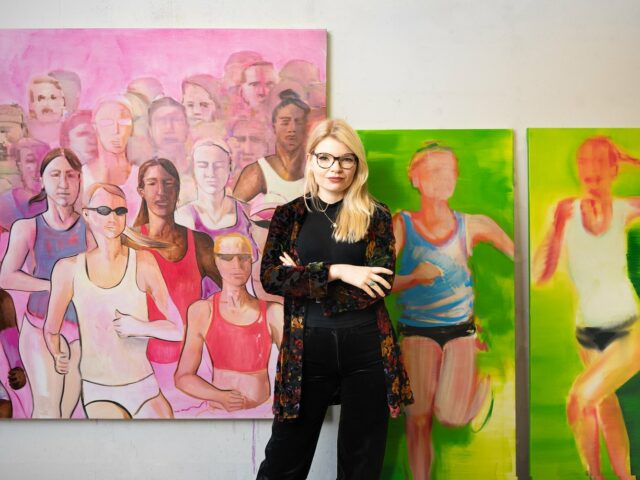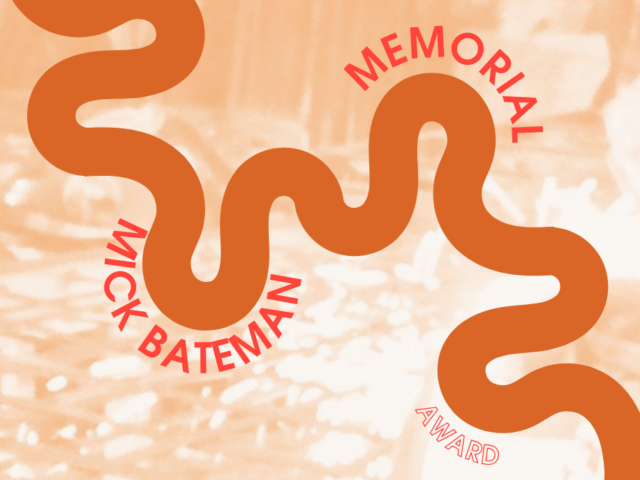Laura Wilson: V&A East X Bow Arts Fellowship
Bow Arts interviews Laura Wilson about the V&A East X Bow Arts Fellowship, and the rich history of textiles within Newham.
The V&A has partnered with Bow Arts to create two Artist Fellowships, offering funding and a workspace for artists at Bow Arts’ Royal Albert Wharf site, situated in the Docklands in east London.
The fellowships are site-specific, creating space to explore histories and practices of making, manufacturing, and materials in the Newham area ahead of the opening of the V&A East Museum and Storehouse in east London in 2025.
Laura Wilson is the second artist in residence from January – March 2024.
Laura, whose previous work has stemmed from an interest in how everyday materials, such as bricks and linen, have transmitted historical and embodied knowledge between people over time and place.

Hi Laura, can you please explain a little about yourself and your art practice?
I am an artist based in London, originally from Northern Ireland. I moved here as a student where I studied BA Fine Art in Sculpture at Central Saint Martins. I stayed in London once I graduated, but have been lucky to travel with my work with exhibitions and research, nationally and internationally.
I have been commissioned and exhibited my work with a wide range of organisations including: CCA Derry-Londonderry; Site Gallery, Sheffield, The Collection Museum, Lincoln with Mansions of the Future, UK; First Draft, Sydney, Australia; 5th Istanbul Design Biennial; Norwich Castle Museum and Art Gallery, Norwich, UK; The British Museum, London, UK with Block Universe; The Petrie Museum of Egyptian Archaeology, London, UK; SPACE, London, UK; V&A Museum, London, UK; Delfina Foundation, London, UK and Site gallery, Sheffield, UK. I became a Churchill Fellow in 2011, and was awarded the inaugural Jerwood New Work Fund, and the Dover Prize 2021.
I work across sculpture, performance, video and drawings, and I’m really interested in how history is carried and evolved through materials over time and place. In particular, how these materials relate to craftwork and labour, the passing on of skills, trades or recipes through generations, how knowledge is shared, memory and embodied knowledge.
My work is quite research based, which takes me out of the studio frequently – to libraries, museum archives, kitchens, factories, laboratories, or building sites. As a result of this, a lot of my work involves me working alongside specialists to better understand the material and the context involved, over the last 5 years this has included bakers, scientists, dancers, millers, chefs, and archaeologists.
For your V&A East X Bow Arts Fellowship you are exploring the histories and practices of making, manufacturing and materials in Newham, with a particular interest in the ecologies of fabric production and women’s workwear. Can you tell us more about this and how it relates to previous works for example Winding, then Winding (2023)?
I’m so excited to be a V&A East X Bow Arts Fellow where I’m working with textile specialists, historians and local people in east London to investigate the rich history of textiles in the London Borough of Newham, with a particular focus on the clothes which women would have worn in the manufacturing industries in the twentieth century for example: soap-makers, flour mills, oil storage, dye works, timber yards, munitions factories and the sugar-refiner Tate & Lyle. To research the social and political history of workwear and the fabric used to construct it, to learn how it is made. I’m interested in how the cloth worn in the workplace draws attention to the increasing pace of mechanical production and often invisible, outsourced labour of today’s new technologies and unsustainable production of fabrics for fast fashion as well as the relationship between woman’s work and labour.
This proposal builds on previous commissions over the last five years exploring themes around craftwork, labour and everyday human interaction – exploring the embodied knowledge and how the body learns, adapts, responds and performs. In 2021 I was awarded the Dover Prize which enabled me to buy a loom. over the last few years I have been researching linen, and learning how to weave by hand. I researched the production and export of linen in Northern Ireland and the history of Linenopolis, the name given to my home city of Belfast in the 19th Century when it was at the centre of the world’s linen industry. This led me to investigate my own family history and the discovery that my ancestors worked in factories in Portadown and Lisburn as weavers, warpers, and yarn winders.
I made several new linen weavings inspired by how information is passed through generations and the physical movement of operating a loom in parallel with my changing pregnant body, including Winding, then Winding (2023) which was produced post-partum and takes its structure from the cycle of my day caring for my son – changing the weaving pattern or weft yarn following nursing or soothing – the linen maps the passage of time as a new parent. Circling (2023) is a weaving which I began with my mother, who I taught how to weave. We wove together on the first day of the exhibition Seams at CCA Derry-Londonderry. Shortly after this my mother passed away and I finished the weaving that we started together.
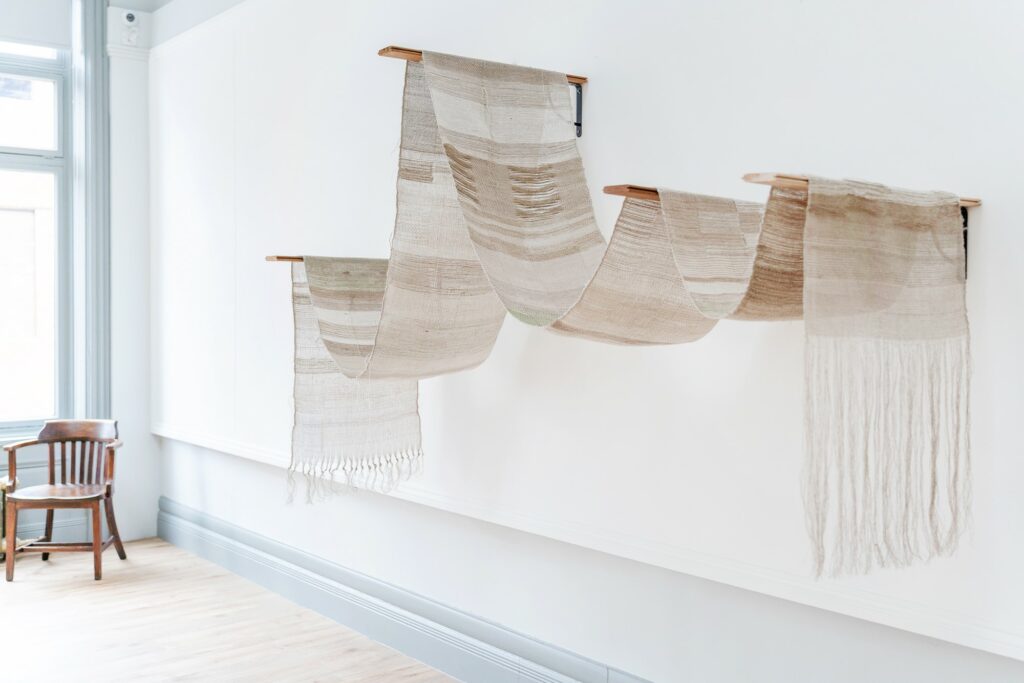
Can you tell use more about what you have been doing during your fellowship?
I have been getting to know the V&A collections, including the Print and Drawing Room and the National Art Library with V&A colleagues. It has been fascinating to look at photographs, artworks and artifacts in the collection which relate to woman and work, in particular there are a lot of images of women taking part in war work – doing jobs which previously would have been held by men.
To get to know the context of east London I have visited local museums and archives. The Museum of Docklands documents the history of London’s Docks, the changing industry and it was interesting in particular to see where my studio is at Royal Albert Wharf on the edge of the River Thames. I also visited the exhibition Fashion City: How Jewish Londoners Shaped global style which was interesting to find out more about the textile industry in the area.
Newham’s Local Study archive has been key to my research where I was able to view and handle objects including clothing which would have been worn in munitions factories by a women. They also have a brilliant collection of photographs documenting women working in different industries in the borough, including those pictured here: Milkmaids at Manor Park Dairy, 1940; Typist as John Knight Ltd, 1900, Mrs D Turner, First East Ham Conductress,1917.
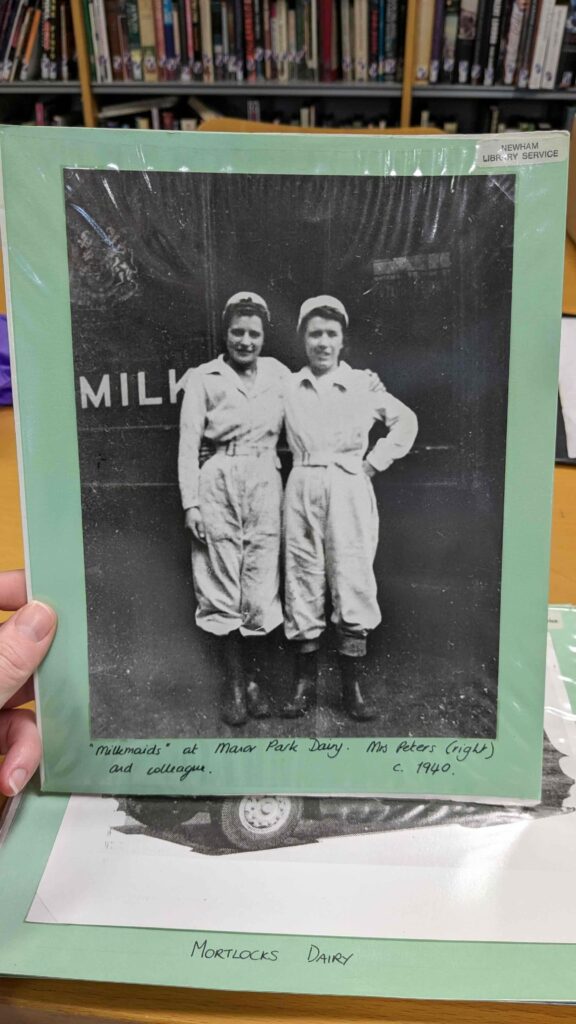
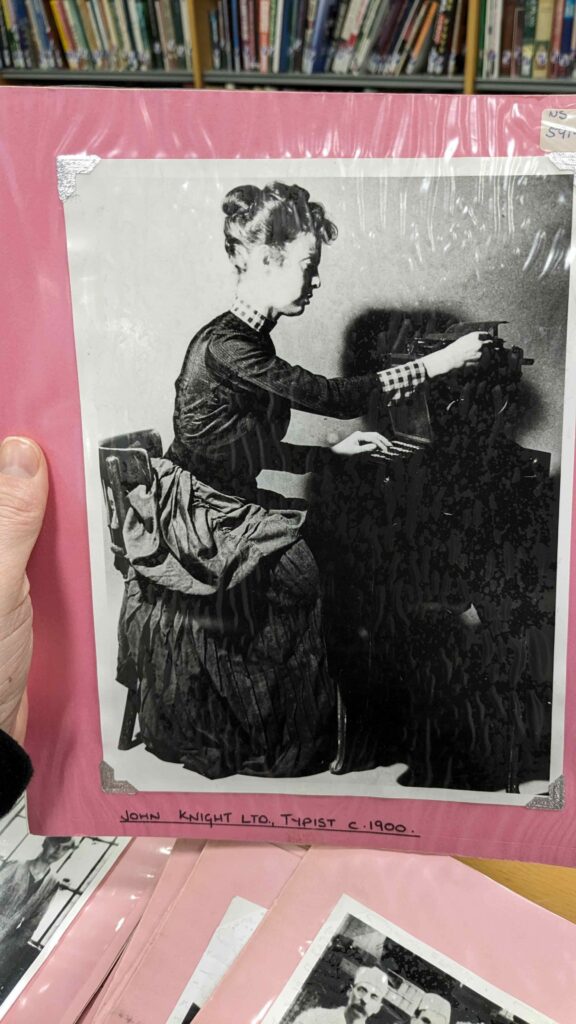
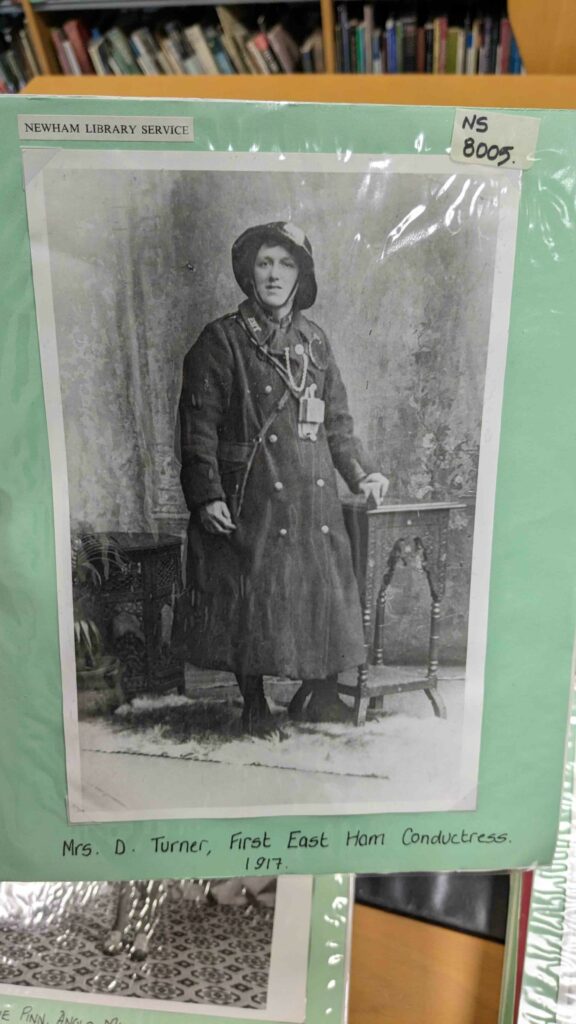
To research women’s workwear further and open up the conversation I have developed a working group based at London College of Fashion in collaboration with Caroline Stevenson, Programme Director of Fashion Studies. We have brought together textile specialists including: historians, pattern cutter and fashion designers to discuss the cloth, construction of uniforms and the related social and political history, to discuss contemporary issues relating to women and the workplace.
Alongside this I have been doing ongoing research, experimentation, and artwork development in studio.
As you are nearing the end of the fellowship, can you share a little on what you envisage this outcome to be?
As part of my research I have been looking into the history of textiles and dye making in the local area – Perkin’s Purple – mauveine – the first synthetic dye which was discovered in east London on Cable street, and at Atlas Works in Hackney Wick they first discovered Meldola’s Blue.
With the studio being on the river I really wanted to make something using the water drawn from the Thames. I have been making watercolours and I’ve started experimenting with making natural dyes using the water from the river made with materials found local to the studio e.g. food waste or plants growing nearby. I plan to dye fabric bought from Hardwick Textiles, a family run fabric shop who have been trading in Upton Park for almost 80 years.
I’m not quite sure at this stage what the outcome will be as I’m still developing the work, but I will be opening my studio at the end of the month as part of Bow Arts’ Royal Albert Wharf Open Studios, so you are welcome to pop by and see what I’ve been doing then.
Your evolving artwork “Trained on Veda” has been developed with multiple organisations, one of which is Bow Arts partner TACO!. Can you tell us more about this long-term project?

Trained on Veda (trainedonveda.com) is an evolving artwork connecting bakeries and galleries through a small malted loaf called veda bread. This work builds on my work around the production of bread, yeast and dough, and my ongoing interest in how knowledge is passed on through embodied practice.
It was initiated during my 2016 residency at Delfina Foundation and developed with TACO!; Site Gallery, Grand Union, and exhibited in Food: Bigger than the Plate at the V&A Museum (2019). This long-term project has involved me collaborating and working with a range of people, from bakers, to workshop participants, millers, curators, and museum conservators.
For the Istanbul Design Biennale – Empathy Revisited: Designs for More than One I made a video work for their Critical Cooking Show in collaboration with Turkish chef Irem Aksu where we discuss the word “veda” and cook a collaborative dish – Trained on Veda Almond Tarator with Baked Hake and Samphire Tempura, inspired by veda bread and their respective heritages (Northern Irish and Turkish). You can view the video here: https://www.e-flux.com/architechture/critical-cooking-show/358104/veda/
Finally, please tell us about your artistic inspiration and influences!
I’m inspired by history, travelling, food, museums, the cinema. I love cooking for people and sharing recipes.

